Anti-Mormon protesters at the
October 2002 LDS General Conference
They say that a picture is worth a thousand words. These pictures provide a small glimpse at the efforts of some critics of the Church of Jesus Christ of Latter-day Saints. These pictures were taken October 4-6, 2002, in Salt Lake City, during an LDS General Conference. Protesters positioned themselves all around Temple Square and along the west side of the Conference Center. These pictures were taken by Allen Wyatt.
Under each picture you will find some comments by the photographer, as well as some links that provide additional information that explain the sensationalistic claims of the protesters. Unfortunately these are still pictures, so they don’t convey the yelling and screaming being done by many of the protesters.
We allow all people to worship who, where, or what they may–and trust the reader can determine if picketing a sacred edifice is Christian behavior.

A protester states his belief about the Church. Somehow the young member to whom
he is talking just doesn’t look like a cult member.
- Are Mormons Christians?—Are Mormons Christians? Do they worship Jesus Christ? Critics use self-serving categories to deny that members of the Church of Jesus Christ of Latter-day Saints worship and revere Jesus. (Link)
- Mormonism is a cult?—Critics claim that the Church is “a cult.” (Link)

Protesting outside the south gate of Temple Square, a Christian fails to realize
(or refuses to believe) that the LDS agree with the statement on his sign.
- Atonement—Critics seriously understate the position of the Church of Jesus Christ with respect to the atonement. (Link)
- LDS view of the atonement—Statements regarding the LDS view of the atonement (Link)
- Comparing the LDS and evangelical Christian views of the atonement—Critics often make comparisons of what they claim are LDS views of the atonement against evangelical Christian views in an attempt to discredit the LDS perspective. (Link)

This person would seem to be in a more precarious position than the LDS he is
protesting against. The LDS believe the Bible to be the word of God, but we
also believe in additional scripture. If that additional scripture is also the
“word of Christ,” won’t that word judge the protester at the last day if he rejects it?
- Basics—Latter-day Saints consider the Bible to be holy scripture. (Link)
- Trustworthy?—Critics claim that Latter-day Saint leaders diminish the Bible as untrustworthy. (Link)
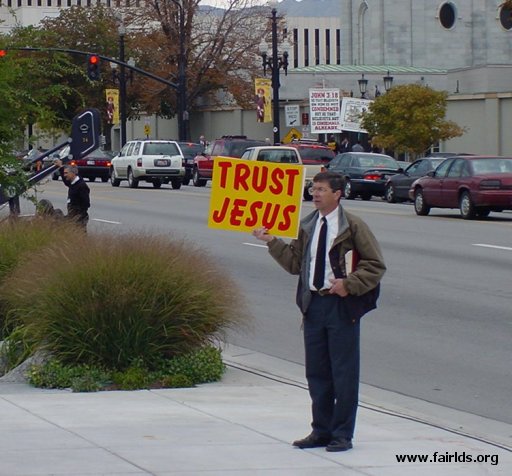
How can one not trust his Lord and Savior?
Notice the protesters across the street in the background, as well.
- Latter-day Saints aren’t Christians?—Critics claim that members of the Church of Jesus Christ of Latter-day Saints are not “Christian.” A related claim is that the Church has only recently begun to portray itself as “Christian” in order to gain adherents. (Link)
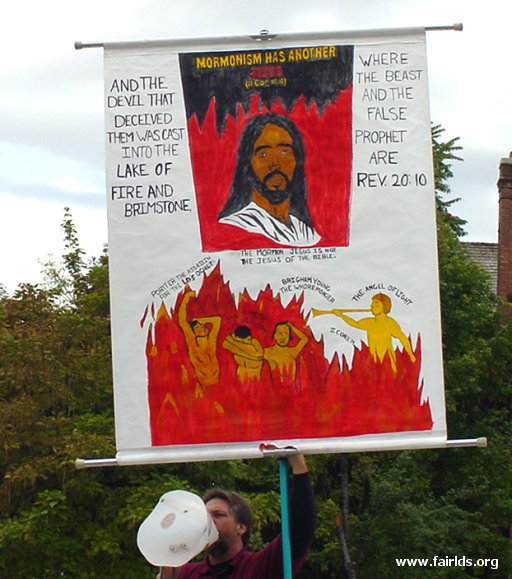
Notice the megaphone used to shout criticisms, mixed with scriptures, at those
attending General Conference. (Somehow I can’t envision the “still small voice”
of the Spirit using a megaphone.) The wording at the bottom of the sign refers to
‘Portter [sic] Rockwell, assassin for the LDS occult’ and ‘Brigham Young the whoremonger.’
It is refreshing to see Christian charity and love in action.
- Worship a “different Jesus”?—Critics claim that members of the Church worship “a different Jesus” than the Jesus worshiped by Christians. (Link)
- Early members believed in “witchcraft?”—Critics claim that early members of the Church believed in witchcraft. They use this to imply or argue that this supports their view of Joseph Smith as involved in “the occult.” (Link)
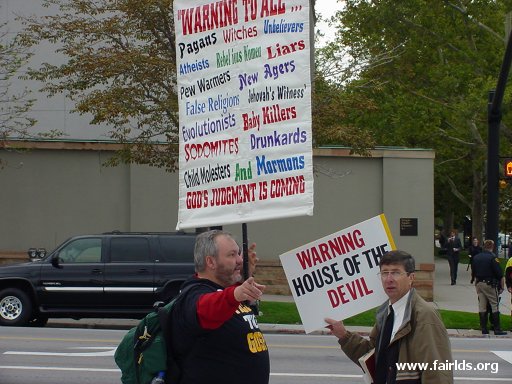
This protester believes the LDS are condemned to Hell with
a host of others, many guilty of grievous sins.
- Concept of Hell—Critics manage to mangle the Christian view of Hell as badly as they do with the correct, authentic and original Christian view of Heaven. They don’t start off well, confusing both the New Testament concepts of Hell in the sense of “hades” or “sheol” (spirit prison) and “gehenna” (everlasting burning)-terms with completely different meanings-and using the terms interchangeably, blissfully ignorant of the distinctions LDS (and the Bible, and most other Christians) make between the two. While it is probably true that, as they say, “…many [Latter-day Saints] find the [Biblicist] view of hell (eternal punishment with no second chances) to be both unfair and offensive,” what offends us even more is that such an oversimplification is not Christian doctrine. Oddly enough, they are not even representing normative Protestant doctrine when they fail to make a difference between hades/sheol and gehenna. (Link)
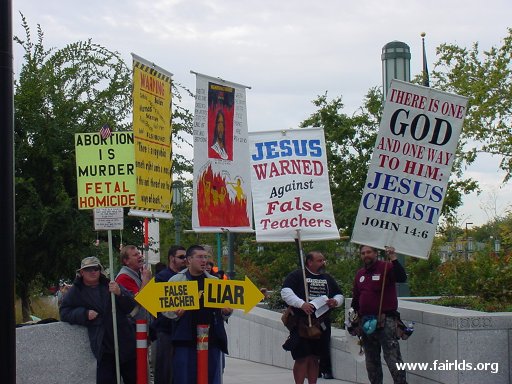
The LDS believe in continuing revelation, and that prophets help us avoid false teachers.
The arrows are protesting the LDS, not protesting the protesters.
- No more prophets after Christ?—Most of Christianity today claim that there are not supposed to be any more prophets after Christ’s day. (Link)

It is ironic that some anti-Mormon protesters actually protested a fellow
anti-Mormon for a time. These gentlemen are protesting James White, a prominent
anti-Mormon. The man in the skull cap is mocking James White, who shaves his head.
Notice the references to “King James White.”
- Alleged false prophecies—Critics claim that Joseph Smith was not a true prophet, and that he made “false prophecies.” (Link)
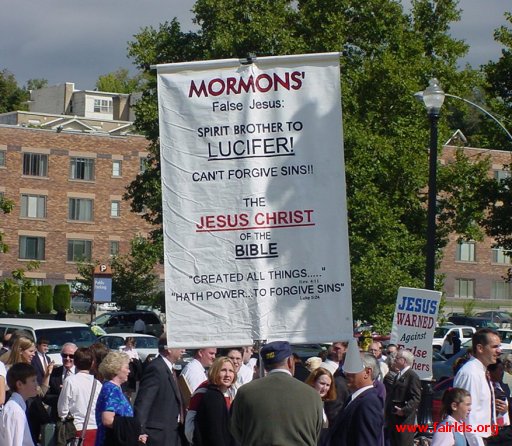
It is shocking to some that the LDS might believe Satan and Jesus are brothers.
Notice the megaphone hanging off the right side of the sign.
- Brother of Satan?—Critics claim that the LDS consider Jesus and Satan to be “brothers,” thus lowering the stature of Christ, or elevating Satan. Some go so far as to imply that the LDS “really” worship or revere Satan, and are thus not true “Christians.” (Link)
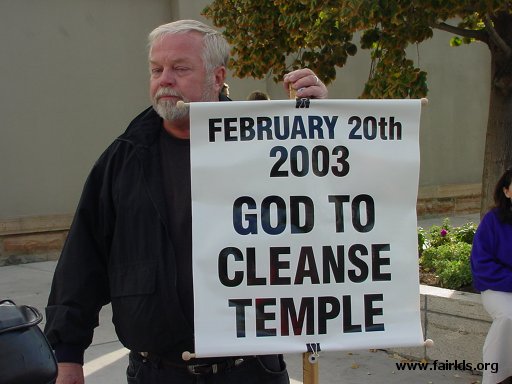
When I asked this gentleman how the temple would be cleansed, he said he didn’t
know, but had received a message from God that it would happen on this day.
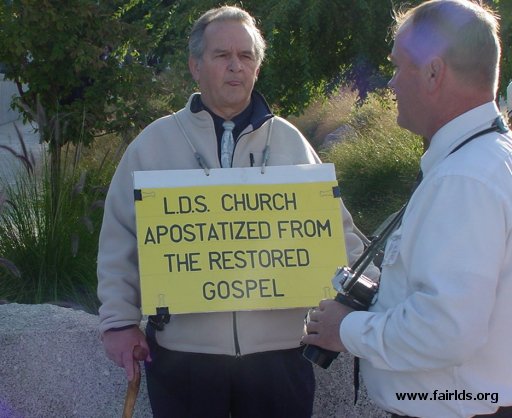
The gentleman with the sign believes in polygamy and that the LDS Church is untrue
because it no longer practices polygamy. Ironically, other nearby protesters felt
that the LDS Church was untrue because it practiced polygamy at one time.
- Prediction of—Does the Bible predict that an apostasy would occur? (Link)
- Purpose of plural marriage—Why would the Lord have commanded the 19th century Saints to implement plural marriage? What purpose(s) did polygamy accomplish? (Link)
- Apostate Groups (Link)
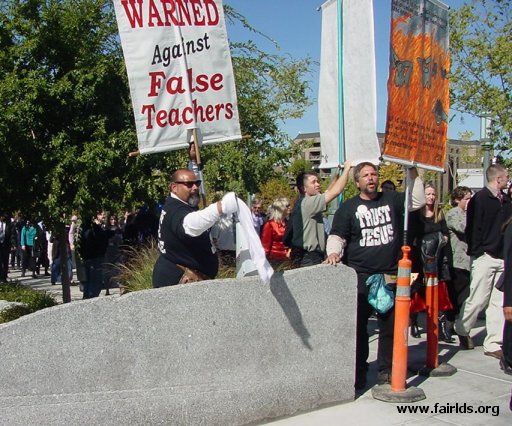
This protester was waving a pair of garments and making slurs concerning “magic
underwear.” I wonder if, in a different venue, he would be waving a yamikah (kipah)
and making anti-Semitic slurs.
- Garments—Hostile critics of the Restoration often mock the LDS practice of wearing temple garments. They refer to these ritual items of clothing as “magic underwear” in order to shock, ridicule and offend. (Link)
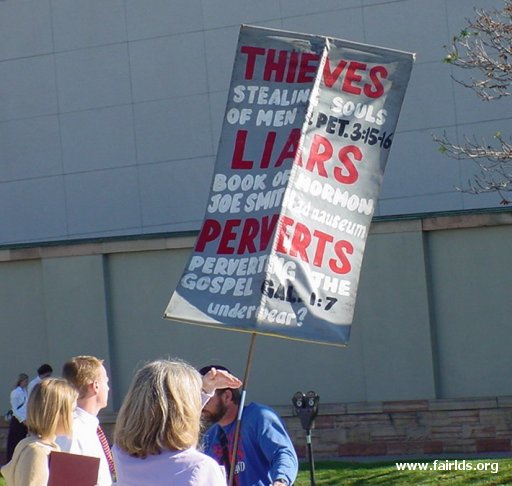
Another reference to our underwear. *sigh*
And the LDS are “thieves, liars, and perverts.”
- Anti-Mormon—Some critics of the Church object to the use of the term “anti-Mormon.” They do not like to be referred to as “anti-Mormons,” and deny that their books, speeches, blogs or videos are “anti-Mormon.” Such critics often insist that the term “anti-Mormon” is unfair because they are not “against” Mormons, but only write and act as they do because they “love” Mormons or Mormon investigators and want to bring them to the truth. (Link)
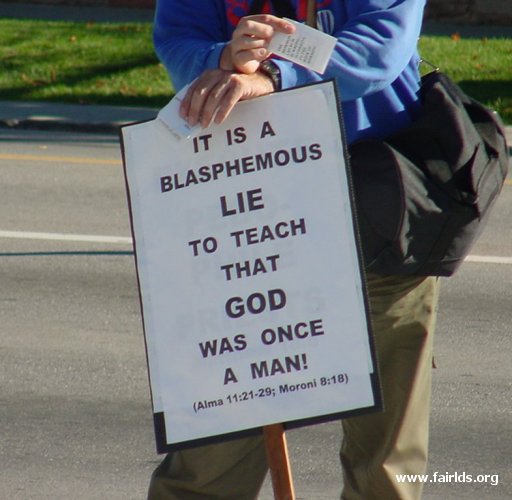
This protester was shouting how he had read the Book of Mormon twice,
and that he was willing to share his printed review. (It is a small,
folded paper, shown in his hand.) He dared the LDS to read it. I read
it in about two minutes. I liked reading the book much better.
- Corporality—Critics attack the LDS doctrine of God the Father and Jesus Christ being corporeal beings—i.e., having physical bodies. They claim that this doctrine is not Biblical. (Link)
- “God is a man”—Critics object to the LDS position that God has a physical body and human form by quoting scripture which says that “God is not a man” (e.g. Numbers 23:19, 1 Samuel 15:29, Hosea 11:9). (Link)

